Kentucky Pesticide Safety Education Program

Questions?
Contact
Dr. Ric Bessin
Dept. of Entomology
University of Kentucky
859-257-7450
rbessin@email.uky.edu
Pesticide accidents and emergencies are rare but they do occur. Some can be catastrophic. Pesticide spills or burning storage facilities can contaminate water, soil, and air and endanger the health of the applicator and emergency responders. They also may lead to financial loss due to cleanup, liability claims, and fines assessed by government agencies. Do all that you can to prevent accidents and be prepared in case of an emergency.
Developing Your Response Plan
A carefully thought-out response plan can help to prevent an emergency from becoming a catastrophe. It also helps to protect employees and communities, to minimize environmental damage, and may reduce liability if an accident happens. Emergencies can take many forms: tornado or high winds, flood, fire, or a highway accident. How you and emergency personnel respond determines whether the problem is handled quickly and safely.
Develop Your Plan:
![]() Designate an emergency coordinator to make important decisions during an emergency, including coordinating with local first responders, such as fire, police, and paramedics. This person will make the necessary calls and fill out reports to government agencies.
Designate an emergency coordinator to make important decisions during an emergency, including coordinating with local first responders, such as fire, police, and paramedics. This person will make the necessary calls and fill out reports to government agencies.
![]() Post a list of names and phone numbers in the office, shop, and truck of response agencies that may require notification.
Post a list of names and phone numbers in the office, shop, and truck of response agencies that may require notification.
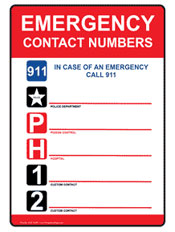
![]() Prepare a/an:
Prepare a/an:
- Form or an outline of critical information to give to emergency personnel. Keep it with the calling list. Be sure to include: the name of the person reporting the incident; the precise location of the incident; and a general description of what happened.
- The exact name, quantity, and classification of pesticides involved; the extent of injuries (if any) and whether pesticides have entered surface water.
- Facility map that shows a layout of all chemical storage buildings and bulk storage tanks; access roads; main shutoffs for electricity, water, and gas; perimeter fencing or gates; fuel storage tanks; the location of fire alarms, fire extinguishers and other firefighting equipment, and protective clothing; and drainage ditches, wells, and surface flow of water.
- Area map that shows your facility in relation to the surrounding area. Provide emergency response agencies with an updated copy of the facility map and area map whenever changes are made.
![]() Keep an inventory of chemicals stored at the facility. Let your emergency response plan show peak seasonal storage of pesticides, fertilizers, and fuel. Store copies of pesticide labels and Safety Data Sheets (SDSs) away from the storage area.
Keep an inventory of chemicals stored at the facility. Let your emergency response plan show peak seasonal storage of pesticides, fertilizers, and fuel. Store copies of pesticide labels and Safety Data Sheets (SDSs) away from the storage area.
![]() Maintain the emergency equipment and supplies needed to respond to fires and spills.
Maintain the emergency equipment and supplies needed to respond to fires and spills.
![]() Train all employees how to execute the response plan each year.
Train all employees how to execute the response plan each year.
Determine Actions to Take in a Crisis
The backbone of any emergency response plan is a description of the sequence of actions to take in a crisis. Prepare step-by-step procedures on how to respond to various emergencies: fires, spills, storms, and transportation accidents, etc. Specify in writing every activity from sounding the alarm to interacting with local emergency response agencies. Once internal emergency procedures have been established, ask your local response agencies if they have anything to add to your plan. Offer them a copy of your plan for their files.
[return]
Fires & Pesticides
Pesticide products vary significantly in their flammability. However, any pesticide product involved in a fire is dangerous to responders working at the scene because of smoke and fumes. Even after the fire has been put out, pesticide residue in the debris, soil, and runoff may be dangerous.
Precautions to Reduce Fire Hazards
Chapter 7 discussed where to locate a pesticide storage facility and proper design and components of a secure facility.
Follow these guidelines to help you prepare for-and respond to-a fire in the storage area:
- Store combustible pesticides away from heating sources.
- Install a fire-detection system.
- Train employees to use a fire extinguisher. Prompt action is essential when a fire occurs. Coordinate all details on managing a fire with local emergency response officials.
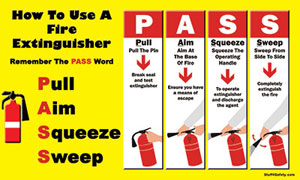
Take the following actions:
- Make sure employees evacuating the premises go to a designated rendezvous point to be counted.
- Notify the fire department.
- Provide emergency response teams with SDSs, labels, the emergency plan, and a site map.
- Follow the instructions given by the onsite incident commander.
- Establish a security perimeter to discourage onlookers.
- Contain contaminated runoff water and leaking pesticide onsite by building berms.
- Consult with emergency responders to decide whether to allow the fire to burn out.
- Call your insurance agent.
- Make all regulatory phone calls required by state and federal agencies.
[return]
Pesticide Spills
A spill is an accidental release of any amount of pesticide, small or large. Spills on public highways, such as when a tank on a truck overturns, usually have major consequences. Failure to respond quickly and appropriately to such mishaps could seriously endanger public health and environmental quality.
In the event of any pesticide spill, remember the three C's: CONTROL the spill, CONTAIN it, and CLEAN it up.
Control the Spill
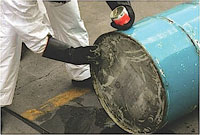
Plug a puncture to stop the spill
Act immediately to control the spilled product. Always put on the appropriate personal protective equipment (PPE) before responding to a spill. Place small, leaking containers into larger ones. If a larger container (such as a drum) is leaking, try to plug the leak. Then, transfer the contents to another container. Turn off the pump to stop leaks from pressurized systems (such as sprayers). Never leave the site unattended.
Contain the Spill
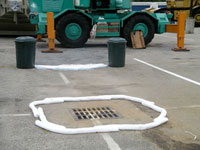
Protect drains and waterways
Do all you can to keep the spill from spreading or getting worse. Prevent the material from entering surface water. Using a shovel, you can quickly berm off an area to keep the spilled pesticide out of drains and waterways. A spill that is contained on the surface is much easier to clean than one that has entered a body of water.
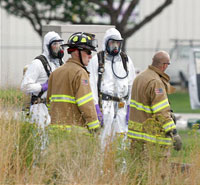
If the spilled pesticide does contaminate a stream, pond, or other waterway, immediately contact the state regulatory agencies responsible for streams and fisheries and for pesticides. Do not delay notifying the authorities. They need time to alert downstream users who draw surface water for drinking, prevent accidental poisoning of livestock, evacuate people using the water for recreational purposes (such as swimming and fishing), and avoid contamination of irrigated crops. Call the manufacturer's emergency number on the SDS to find out what steps you or the emergency response coordinator should take to lessen the dangers of water contamination.
Call 911 to report the spill and be ready to respond to the authorities arriving at the scene. Be sure to have the product label and SDS available for emergency responders. After the spill has been contained, follow your emergency plan. In some cases, the applicator will call the emergency responder, who will then call the proper authorities.
Clean up the Spill
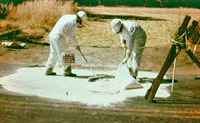
Clean up the spill
The last step is to clean up the spilled product. Sweep up any absorbent materials and other contaminated items and place them in a drum. If the spill occurred on concrete or asphalt, you will have to neutralize the surface. Follow the instructions on the SDS or contact the manufacturer, whose number is listed on the data sheet.
The state regulatory agency will tell you what to do when the spill occurs on soil. The only effective way to decontaminate soil saturated with a pesticide is to remove the top 2 to 3 inches and replace it with fresh topsoil.
Areas contaminated by application errors or minor spills can sometimes be cleaned by immediately applying activated charcoal to the contaminated surface. The charcoal can adsorb or tie up enough chemical to avoid significant plant injury and long-term contamination. However, applying activated charcoal to areas where large spills have occurred will do little to reduce soil contamination and subsequent plant damage.
Clean the Equipment and Vehicles
Clean any equipment and vehicles that were contaminated either as a result of the original accident or during the clean-up procedure. Before you begin, however, be sure you are properly clothed and protected to avoid contact with the chemical. Use ordinary household bleach in water (approximately 30 percent bleach) or an alkaline detergent (dishwasher soap) solution to clean your equipment. Do not mix bleach and alkaline detergent together as this is a hazardous combination.
Keep records of your activities and conversations with regulatory authorities, emergency responders, news media, and the public when dealing with a pesticide spill. Photographs help document any related damage as well as steps you have taken to clean up the spilled product.
Prevent Spills
A key to reducing the likelihood of any spill is to properly maintain your application equipment and transport vehicles. Leaks and drips from cracked hoses or loose hose clamps clearly indicate problems. Defensive driving techniques and refraining from cellphone use while driving are two important habits that can prevent vehicle accidents that might result in a spill.
Spill Cleanup Kit
Keep a spill cleanup kit in each pesticide transport vehicle and at the site where pesticides are mixed, loaded, and stored. Store your spill kit items in a plastic container and keep them clean and in working order.
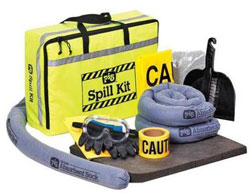
Include the following items in a spill response kit:
- Telephone numbers for emergency assistance.
- PPE designed for use with pesticides.
- Absorbent materials, such as spill pillows, absorbent clay, and cat litter.
- A shovel, broom, and dustpan.
- Heavy-duty detergent.
[return]
Summary
Prepare for a pesticide emergency. Make sure the plan includes designating an emergency response coordinator, maintaining a list of emergency response agencies, preparing a map of the facility, and keeping a product inventory. Be sure all employees at the facility are familiar with the emergency response plan and know what to do in a crisis. Take precautions to reduce the chance of pesticide fires.The best way to manage pesticide spills is to prevent them from happening. It is your responsibility as a pesticide applicator to do everything possible to avoid spills and adhere to a few basic guidelines when handling spills and leaks. Accidents happen. Be prepared so that they will not become catastrophes.
[return]
1) Any pesticide product involved in a fire is most dangerous to responders working at the scene because of ____________.
2) Which one of the following is the correct sequence for using a fire extinguisher?
- Sweep, Aim, Pull, Squeeze
- Pull, Aim, Squeeze, Sweep
- Pull, Aim, Sweep, Squeeze
- Squeeze, Pull, Aim, Sweep
3) Which one of the following is the correct sequence for responding to a pesticide spill?
4) Which one of the following actions is the first thing to do when responding to a pesticide spill?
- Leave the spill site to get the product's label and Safety Data Sheet
- Put on the appropriate personal protective equipment
- Open the spill kit
5) The only effective way to decontaminate soil saturated with a pesticide is to __________.
- remove the top 2 to 3 inches of soil
- cover the area with 2 to 3 inches of soil
- sprinkle the soil with lime
6) Any large spill of a iquid pesticide concentrate should be _____________.
- immediately washed away
- directed into a storm drain, creek, or pond
- covered with absorbent material
- sprinkled with bleach
7) What is the best source of information about neutralizing spills on concrete or asphalt after the pesticide has been removed?
8) Always have a copy of the ________ in your vehicle in case of a spill or accident.
9) It is easier to clean a spilled pesticide after it has entered into water.
10) A shovel and broom are the best tools to use when cleaning up a spilled _______ formulation.
11) Use __________ to clean your equipment after a pesticide spill.
- a 30% mixture of household bleach and alkaline detergent
- gasoline or kerosene
- a dusting of slaked lime
- household bleach in water or an alkaline detergent
Image credits: Emergency contact list | fire extinguisher poster | Protect drains |
Emergency personnel | Spill cleanup | Spill cleanup kit
website design by P.M. Dillon | content by L. Townsend, Dept. of Entomology, Univesity of Kentucky
copyright © 2016 University of Kentucky Department of Entomology
University of Kentucky College of Agriculture |
S-225 Agricultural Science Center North, Lexington, KY 40546-0091 | 859.257.7450
An Equal Opportunity University |
Last modified
11/30/2018
